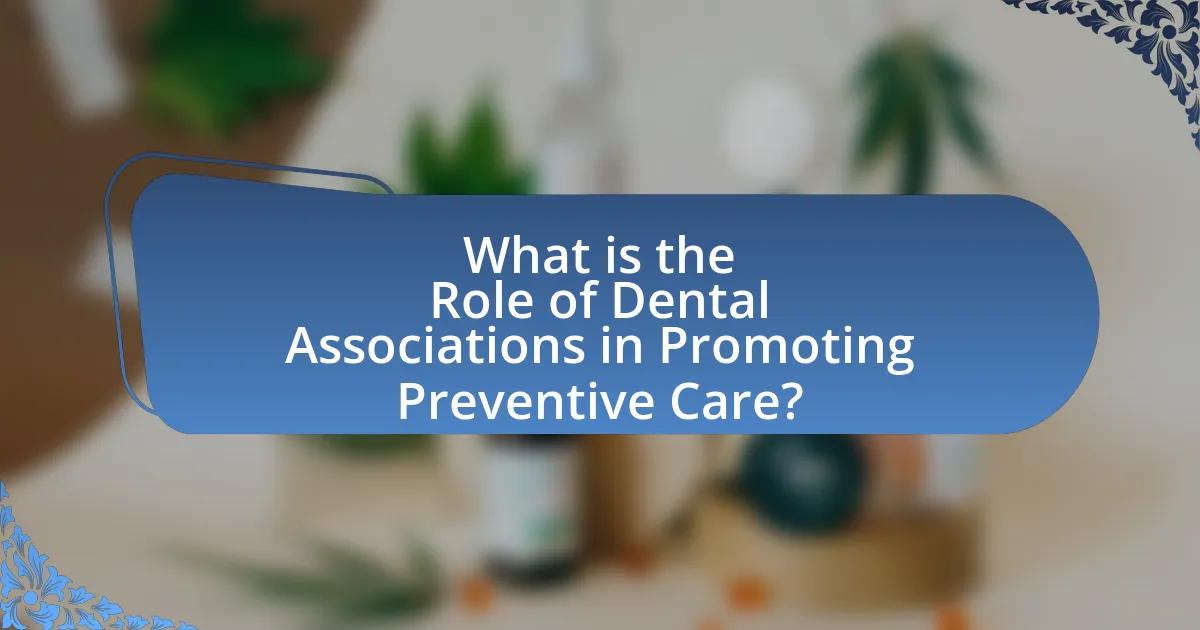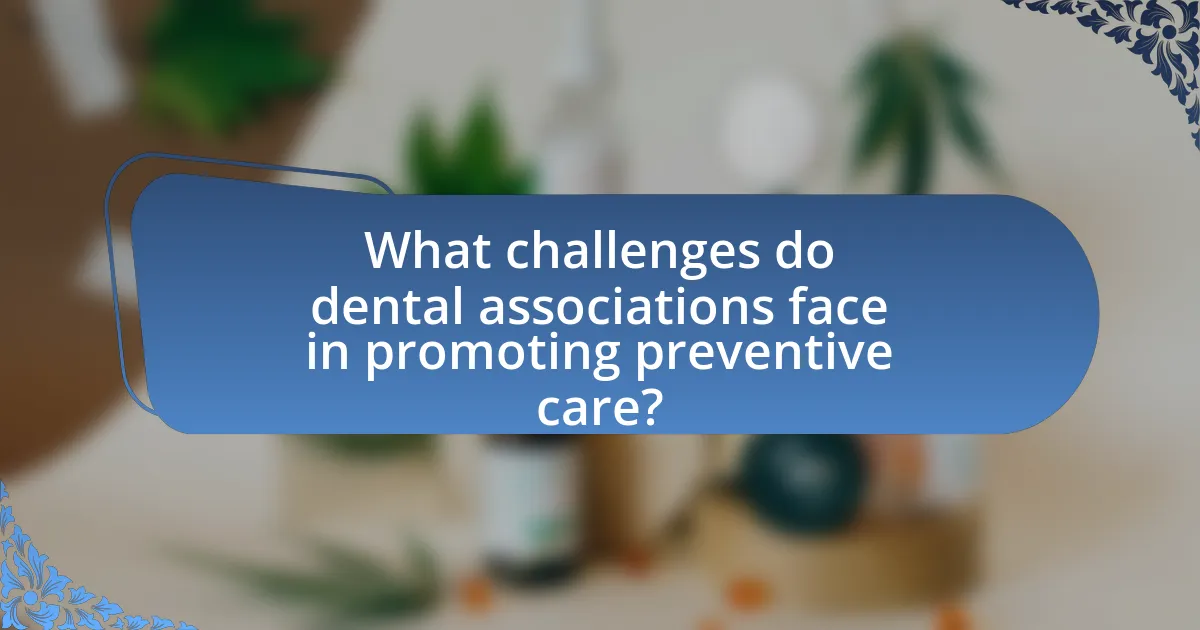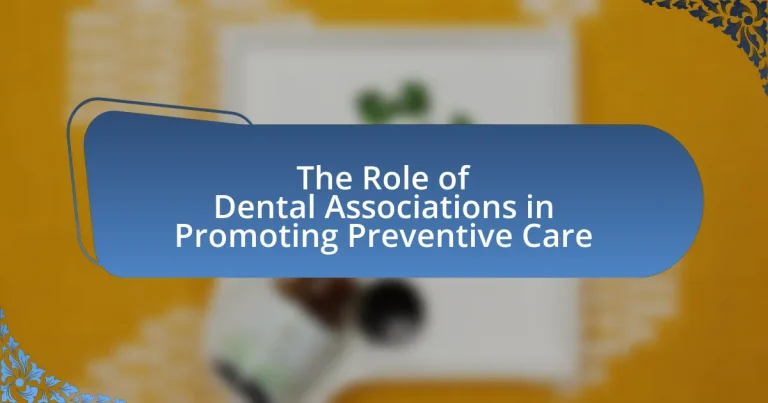Dental associations play a vital role in promoting preventive care within the field of dentistry by providing education, resources, and guidelines to both professionals and the public. They define preventive care as practices aimed at maintaining oral health, which includes regular check-ups, cleanings, and treatments like fluoride applications and sealants. Key initiatives undertaken by these associations include public awareness campaigns, educational programs, and collaborations with schools and healthcare organizations to enhance outreach and access to preventive services. Despite facing challenges such as limited public awareness and financial constraints, dental associations continue to advocate for preventive care, emphasizing its importance in reducing dental diseases and improving overall health outcomes.

What is the Role of Dental Associations in Promoting Preventive Care?
Dental associations play a crucial role in promoting preventive care by providing education, resources, and guidelines to both dental professionals and the public. These organizations develop and disseminate evidence-based practices that emphasize the importance of regular dental check-ups, proper oral hygiene, and preventive treatments such as fluoride applications and sealants. For instance, the American Dental Association (ADA) has established guidelines that encourage routine screenings and preventive measures, which have been shown to reduce the incidence of dental diseases significantly. Additionally, dental associations often conduct public awareness campaigns that highlight the benefits of preventive care, thereby fostering a culture of oral health that can lead to improved overall health outcomes in communities.
How do dental associations define preventive care?
Dental associations define preventive care as a set of practices aimed at maintaining oral health and preventing dental diseases. This includes regular dental check-ups, cleanings, patient education on oral hygiene, and the application of sealants and fluoride treatments. According to the American Dental Association, preventive care is essential for reducing the incidence of cavities and gum disease, thereby promoting overall health and well-being.
What are the key components of preventive dental care?
The key components of preventive dental care include regular dental check-ups, professional cleanings, patient education, fluoride treatments, and dental sealants. Regular dental check-ups allow for early detection of oral health issues, while professional cleanings remove plaque and tartar that contribute to cavities and gum disease. Patient education empowers individuals to maintain proper oral hygiene practices at home, which is essential for long-term dental health. Fluoride treatments strengthen tooth enamel and help prevent decay, and dental sealants provide a protective barrier on the chewing surfaces of teeth, particularly in children. These components collectively contribute to reducing the incidence of dental diseases and promoting overall oral health.
Why is preventive care important in dentistry?
Preventive care is important in dentistry because it helps to maintain oral health, reduce the risk of dental diseases, and lower overall treatment costs. Regular preventive measures, such as cleanings and check-ups, can identify issues like cavities and gum disease early, which can be treated more easily and effectively. According to the American Dental Association, preventive care can reduce the incidence of dental problems by up to 50%, demonstrating its effectiveness in promoting long-term oral health.
What initiatives do dental associations undertake to promote preventive care?
Dental associations undertake various initiatives to promote preventive care, including public awareness campaigns, educational programs, and policy advocacy. These campaigns often focus on the importance of regular dental check-ups, proper oral hygiene practices, and the benefits of fluoride use. For instance, the American Dental Association (ADA) runs the “Give Kids A Smile” program, which provides free dental care to underserved children, emphasizing the significance of early dental visits. Additionally, dental associations collaborate with schools to implement oral health education, ensuring that children learn about preventive measures from a young age. These initiatives are supported by research indicating that preventive care significantly reduces the incidence of dental diseases, thereby improving overall public health outcomes.
How do educational programs contribute to preventive care awareness?
Educational programs significantly enhance preventive care awareness by providing essential information and resources that empower individuals to make informed health decisions. These programs often include workshops, seminars, and informational materials that educate the public about the importance of preventive measures, such as regular dental check-ups and proper oral hygiene practices. Research indicates that communities with active educational initiatives experience higher rates of preventive care utilization, leading to improved overall health outcomes. For instance, a study published in the Journal of Dental Research found that individuals who participated in educational programs were 30% more likely to engage in preventive dental care compared to those who did not. This demonstrates the effectiveness of educational programs in fostering a culture of preventive care awareness.
What role do public health campaigns play in promoting preventive care?
Public health campaigns play a crucial role in promoting preventive care by raising awareness and educating the public about health risks and preventive measures. These campaigns utilize various media platforms to disseminate information, encouraging individuals to adopt healthier behaviors, such as regular dental check-ups and proper oral hygiene practices. For instance, the Centers for Disease Control and Prevention (CDC) reports that effective public health campaigns can lead to increased vaccination rates and improved health outcomes, demonstrating their impact on preventive care.
How do dental associations collaborate with other organizations?
Dental associations collaborate with other organizations through partnerships, joint initiatives, and advocacy efforts aimed at promoting oral health and preventive care. For instance, they often work with public health agencies, educational institutions, and non-profit organizations to develop community outreach programs that raise awareness about dental hygiene and preventive practices. A notable example is the collaboration between the American Dental Association and the Centers for Disease Control and Prevention, which has led to campaigns that emphasize the importance of fluoride in preventing tooth decay. These collaborations leverage resources and expertise from multiple sectors to enhance the effectiveness of public health messaging and improve access to dental care.
What partnerships enhance the effectiveness of preventive care initiatives?
Collaborations between dental associations, healthcare providers, community organizations, and educational institutions enhance the effectiveness of preventive care initiatives. These partnerships facilitate resource sharing, increase access to preventive services, and promote public awareness about oral health. For instance, dental associations often partner with schools to implement oral health education programs, which have been shown to improve children’s dental hygiene practices and reduce cavities. Additionally, collaborations with local health departments can lead to community-wide screenings and preventive services, significantly increasing the reach and impact of these initiatives.
How do collaborations with schools and communities impact preventive care outreach?
Collaborations with schools and communities significantly enhance preventive care outreach by facilitating access to health education and resources. These partnerships enable dental associations to implement targeted programs that address specific health needs within the community, such as oral hygiene workshops and screenings. For instance, a study published in the Journal of School Health found that school-based dental programs increased student participation in preventive care by 30%, demonstrating the effectiveness of community engagement in promoting health initiatives. By leveraging local networks, these collaborations foster trust and encourage families to prioritize preventive care, ultimately leading to improved health outcomes.

What challenges do dental associations face in promoting preventive care?
Dental associations face several challenges in promoting preventive care, primarily including limited public awareness, financial constraints, and varying levels of access to dental services. Limited public awareness hampers the effectiveness of preventive care initiatives, as many individuals do not recognize the importance of regular dental check-ups and preventive measures. Financial constraints often restrict the ability of dental associations to fund comprehensive outreach programs, which are essential for educating the public about preventive care. Additionally, varying levels of access to dental services create disparities in preventive care adoption, as individuals in underserved areas may lack the resources or facilities to receive adequate dental care. These challenges collectively hinder the efforts of dental associations to effectively promote preventive care within communities.
How do funding and resources affect preventive care initiatives?
Funding and resources significantly influence preventive care initiatives by determining the scope, reach, and effectiveness of programs. Adequate funding allows for the development and implementation of comprehensive preventive care strategies, including educational campaigns, community outreach, and access to necessary materials and services. For instance, a study published in the American Journal of Public Health found that increased funding for preventive health programs led to a measurable reduction in disease incidence and improved health outcomes in communities. Additionally, resources such as trained personnel and technological support enhance the quality of preventive care, enabling dental associations to effectively promote oral health initiatives.
What are the implications of limited funding on preventive care programs?
Limited funding significantly hampers the effectiveness and reach of preventive care programs. When financial resources are constrained, these programs often face reductions in services, leading to decreased access for populations in need. For instance, a study published in the American Journal of Public Health found that states with lower funding for preventive services experienced higher rates of dental diseases among low-income communities. Additionally, limited funding restricts the ability to implement educational initiatives that promote preventive care, resulting in lower public awareness and engagement. Consequently, the overall health outcomes deteriorate, as preventive care is essential for reducing the incidence of chronic diseases and managing healthcare costs effectively.
How can dental associations overcome resource challenges?
Dental associations can overcome resource challenges by leveraging partnerships and collaborations with other healthcare organizations and stakeholders. These partnerships can provide access to shared resources, funding opportunities, and expertise that individual associations may lack. For instance, the American Dental Association has successfully collaborated with public health agencies to enhance preventive care initiatives, demonstrating that collective efforts can lead to more effective resource utilization and improved health outcomes. Additionally, dental associations can implement technology-driven solutions, such as telehealth services, to optimize resource allocation and reach underserved populations, thereby addressing both access and efficiency challenges.
What barriers exist in public perception of preventive dental care?
Barriers in public perception of preventive dental care include misconceptions about the necessity and effectiveness of such care, financial constraints, and lack of awareness regarding the importance of oral health. Many individuals believe that dental visits are only necessary when problems arise, leading to neglect of preventive measures. Financial barriers are significant, as studies indicate that high costs associated with dental care deter individuals from seeking preventive services. Additionally, a lack of education about the benefits of preventive dental care contributes to low engagement, with surveys showing that many people are unaware of how preventive care can reduce long-term dental issues and costs.
How does misinformation impact preventive care practices?
Misinformation significantly undermines preventive care practices by leading individuals to make uninformed health decisions. For instance, false claims about the efficacy of dental treatments can result in patients avoiding necessary preventive measures, such as regular check-ups or vaccinations. A study published in the Journal of Dental Research found that misinformation about fluoride safety led to decreased fluoride use, which is essential for cavity prevention. This demonstrates that misinformation not only affects individual choices but can also have broader public health implications, ultimately increasing the prevalence of preventable dental diseases.
What strategies can dental associations use to improve public understanding?
Dental associations can improve public understanding by implementing educational campaigns that focus on preventive care. These campaigns can utilize various platforms, including social media, community workshops, and informational websites, to disseminate accurate dental health information. For instance, the American Dental Association has successfully used its “Give Kids A Smile” program to educate families about the importance of oral hygiene and regular dental visits, reaching millions of children and parents. Additionally, partnerships with schools and local health organizations can enhance outreach efforts, ensuring that dental health education is accessible to diverse populations.

What future trends are shaping the role of dental associations in preventive care?
Future trends shaping the role of dental associations in preventive care include the integration of technology, increased focus on public health initiatives, and enhanced collaboration with other healthcare sectors. Dental associations are adopting digital tools such as tele-dentistry and mobile health applications to improve access to preventive services, as evidenced by a 2021 study showing that tele-dentistry increased patient engagement by 30%. Additionally, these associations are prioritizing community outreach programs aimed at educating the public on oral health, reflecting a broader public health strategy that aligns with the World Health Organization’s emphasis on preventive care. Furthermore, partnerships with medical organizations are becoming more common, facilitating a holistic approach to health that recognizes the interconnection between oral and overall health, supported by research indicating that oral diseases can significantly impact systemic health outcomes.
How is technology influencing preventive care initiatives?
Technology is significantly influencing preventive care initiatives by enhancing data collection, patient engagement, and treatment personalization. For instance, electronic health records (EHRs) allow for comprehensive tracking of patient histories, enabling healthcare providers to identify risk factors and recommend preventive measures effectively. Additionally, mobile health applications facilitate patient engagement by providing reminders for check-ups and educational resources, which can lead to increased adherence to preventive care protocols. A study published in the Journal of Medical Internet Research found that patients using health apps were 30% more likely to participate in preventive screenings compared to those who did not use such technology. This demonstrates that technology not only streamlines the preventive care process but also actively encourages patient participation, ultimately improving health outcomes.
What digital tools are being utilized to promote preventive care?
Digital tools utilized to promote preventive care include mobile health applications, telehealth platforms, and online educational resources. Mobile health applications, such as those that track oral hygiene habits or provide reminders for dental check-ups, empower patients to take charge of their preventive care. Telehealth platforms facilitate remote consultations, allowing dental professionals to offer guidance and preventive advice without the need for in-person visits. Online educational resources, including webinars and interactive websites, disseminate information about preventive practices and the importance of regular dental visits. These tools enhance patient engagement and awareness, ultimately leading to improved preventive care outcomes.
How can telehealth services enhance preventive care accessibility?
Telehealth services enhance preventive care accessibility by providing remote consultations and follow-ups, which eliminate geographical barriers and reduce the need for in-person visits. This increased accessibility allows patients to receive timely preventive care, such as dental check-ups and screenings, from the comfort of their homes. According to a study published in the Journal of the American Dental Association, telehealth can improve patient engagement and adherence to preventive care recommendations, leading to better health outcomes. Furthermore, telehealth services can facilitate access for underserved populations, ensuring that more individuals receive essential preventive care services.
What best practices can dental associations adopt for effective preventive care promotion?
Dental associations can adopt several best practices for effective preventive care promotion, including the development of comprehensive educational campaigns, collaboration with healthcare providers, and the use of data-driven strategies. Comprehensive educational campaigns can raise awareness about the importance of preventive care, as studies show that informed patients are more likely to engage in preventive behaviors. Collaboration with healthcare providers, such as physicians and community organizations, can enhance outreach efforts and create a multidisciplinary approach to health promotion. Additionally, utilizing data-driven strategies, such as analyzing patient demographics and health trends, allows dental associations to tailor their initiatives to specific community needs, thereby increasing the effectiveness of their preventive care programs.
How can continuous education improve preventive care outreach?
Continuous education enhances preventive care outreach by equipping healthcare professionals with updated knowledge and skills necessary for effective patient engagement. This ongoing training allows practitioners to stay informed about the latest preventive care guidelines, emerging health trends, and innovative outreach strategies. For instance, studies have shown that healthcare providers who participate in continuous education programs are more likely to implement evidence-based practices, leading to improved patient outcomes and increased community awareness about preventive measures. Furthermore, continuous education fosters collaboration among dental associations, enabling the sharing of best practices and resources that amplify outreach efforts.
What role does community engagement play in successful preventive care programs?
Community engagement is crucial for the success of preventive care programs as it fosters trust, enhances awareness, and encourages participation among the target population. Engaged communities are more likely to adopt preventive health behaviors, leading to improved health outcomes. For instance, studies have shown that community-based interventions, which involve local stakeholders, can increase screening rates for diseases such as oral cancer by up to 30%. This demonstrates that when communities are actively involved in the planning and implementation of preventive care initiatives, the effectiveness of these programs significantly improves.


